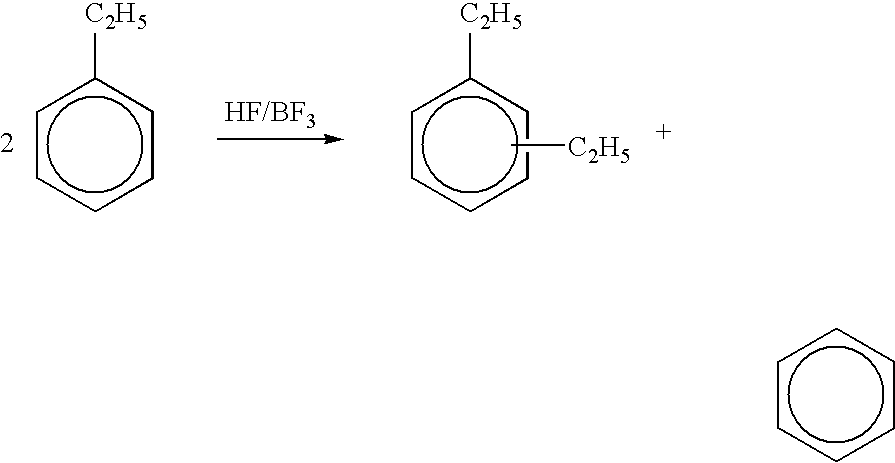Production method of alkylbenzaldehydes
a production method and alkylbenzaldehyde technology, applied in the preparation of carbonyl compounds, organic chemistry, chemistry apparatus and processes, etc., can solve the problems of high catalytic action, difficult catalyst regeneration, and increased waste disposal costs, so as to reduce the volume efficiency of the preparation tank, prevent side reactions, and increase production costs
- Summary
- Abstract
- Description
- Claims
- Application Information
AI Technical Summary
Benefits of technology
Problems solved by technology
Method used
Image
Examples
example 1
[0030] One of two 1-L jacketed autoclaves equipped with a stirrer was used as a preparation tank for a solution of complex and the other was used as a formylation reactor.
[0031] Into the preparation tank, were continuously introduced ethylbenzene containing 0.5 mol % of methylcyclopenatane, hydrogen fluoride and boron trifluoride at respective flow rates of 1.0 mol / h (based on ethylbenzene), 10.0 mol / h and 1.3 mol / h to prepare a solution of complex of ethylbenzene / hydrogen fluoride-boron trifluoride. The solution of complex was continuously pumped into the formylation reactor which had been pressurized by carbon monoxide to a total pressure of 2.0 MPa while maintaining the liquid level so as to control the average residence time in the preparation tank to one hour. The temperature of the preparation tank was controlled to −20° C. by passing a coolant through the jacket, and the pressure was controlled to 0.35 MPa. The temperature of the formylation reactor was maintained at −20° C....
example 2
[0033] The procedure of Example 1 was repeated except for changing the mixing amount of methylcylcopentane with ethylbenzene to 0.1 mol %. The oily substance obtained by separating the catalyst component from the discharged formylation product solution was analyzed by gas chromatography. The conversion of ethylbenzene was 90.5 mol % and the selectivity to p-ethylbenzaldehyde was 95.5 mol %. The contents of other alkylbenzaldehydes were 1.1 mol % for o-ethylbenzaldehyde, 0.1 mol % for m-ethylbenzaldehyde and 1.5 mol % for 2,4-diethylbenzaldehyde, each in terms of the selectivity.
example 3
[0035] The procedure of Example 1 was repeated except for mixing ethylbenzene with isohexane in place of methylcyclopentane. The oily substance obtained by separating the catalyst component from the discharged formylation product solution was analyzed by gas chromatography. The conversion of ethylbenzene was 90.2 mol % and the selectivity to p-ethylbenzaldehyde was 96.8 mol %. The contents of other alkylbenzaldehydes were 1.0 mol % for o-ethylbenzaldehyde, 0.2 mol % for m-ethylbenzaldehyde and 0.8 mol % for 2,4-diethylbenzaldehyde, each in terms of the selectivity.
PUM
| Property | Measurement | Unit |
|---|---|---|
| mol % | aaaaa | aaaaa |
| temperatures | aaaaa | aaaaa |
| pressure | aaaaa | aaaaa |
Abstract
Description
Claims
Application Information
 Login to View More
Login to View More - R&D
- Intellectual Property
- Life Sciences
- Materials
- Tech Scout
- Unparalleled Data Quality
- Higher Quality Content
- 60% Fewer Hallucinations
Browse by: Latest US Patents, China's latest patents, Technical Efficacy Thesaurus, Application Domain, Technology Topic, Popular Technical Reports.
© 2025 PatSnap. All rights reserved.Legal|Privacy policy|Modern Slavery Act Transparency Statement|Sitemap|About US| Contact US: help@patsnap.com

